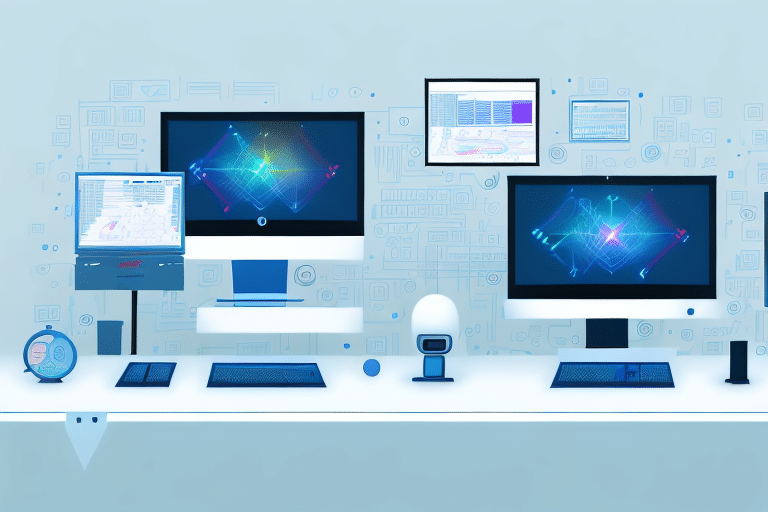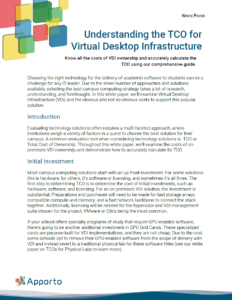Streamlining IT Management: Why Virtual Desktop Infrastructure is a Game-Changer
In today’s fast-paced digital era, businesses need to adapt quickly to changing trends and technologies. One area that has seen tremendous growth and innovation is IT management. With the rise of remote work and the need for more flexible and secure systems, virtual desktop infrastructure (VDI) has emerged as a game-changer. In this article, we will explore the various aspects of VDI and why it is revolutionizing IT management.
Understanding Virtual Desktop Infrastructure
VDI, also known as desktop virtualization, is a technology that enables users to access their desktop operating systems, applications, and data from a centralized server. Instead of running applications and storing data locally on individual devices, VDI allows everything to be hosted and managed on a central server, which can then be accessed by users across multiple devices.
The Basics of VDI
At its core, VDI works by creating multiple virtual machines (VMs) on a server. These VMs act as individual desktops, with each user having their own personalized virtual desktop environment. When users access their virtual desktop, they can continue working seamlessly from any device, as their desktop environment is stored on the server.
Imagine a scenario where employees of a company can access their work desktops from their personal laptops, tablets, or even smartphones. With VDI, this becomes a reality. Whether they are at the office, at home, or on the go, employees can log in to their virtual desktops and have all their files, applications, and settings right at their fingertips.
Not only does this enhance productivity and flexibility, but it also simplifies IT management. Instead of having to configure and maintain individual devices, IT administrators can focus on managing the central server, ensuring that all virtual desktops are up-to-date and secure.
Key Features of VDI
VDI offers several key features that make it an attractive option for businesses:
- Centralized Management: With VDI, IT administrators can manage and update applications, security settings, and user profiles from a central location, eliminating the need to individually configure each device.
- Enhanced Security: VDI provides robust security measures by keeping all data and applications within the secure confines of the server. This reduces the risk of data breaches and allows for better control over sensitive information.
- Flexibility and Mobility: With VDI, employees can access their virtual desktops from any device with internet connectivity, enabling them to work from anywhere, at any time.
Imagine a company with a globally distributed workforce. With VDI, employees located in different parts of the world can collaborate seamlessly. They can access their virtual desktops, work on shared documents, and communicate with their colleagues, all in real-time.
Furthermore, VDI enables businesses to implement strict security measures. By keeping all data and applications within the secure confines of the server, the risk of data breaches is significantly reduced. IT administrators can enforce access controls, implement encryption, and regularly update security protocols to ensure the safety of sensitive information.
Additionally, VDI offers businesses the flexibility to scale their operations. As the company grows, more virtual desktops can be easily provisioned on the central server, accommodating the increasing number of users. This scalability ensures that businesses can adapt to changing demands without the need for extensive hardware upgrades or replacements.
Moreover, VDI promotes a more sustainable approach to computing. By centralizing resources on a server, energy consumption is reduced compared to having multiple devices running independently. This not only benefits the environment but also helps businesses save on energy costs in the long run.
In conclusion, VDI is a powerful technology that revolutionizes the way we work. By centralizing desktop environments and enabling access from any device, it enhances productivity, simplifies IT management, and provides robust security measures. With its flexibility and scalability, VDI is an attractive option for businesses of all sizes, enabling them to embrace the digital age and thrive in an increasingly connected world.
The Role of VDI in IT Management
Virtual desktop infrastructure is a technology that plays a crucial role in simplifying and enhancing various aspects of IT management. By leveraging the power of virtualization, VDI offers a range of benefits that can transform the way organizations handle their IT tasks and ensure a more secure computing environment.
Let’s explore two key areas where VDI makes a significant difference:
Simplifying IT Tasks with VDI
Managing a large number of devices, applications, and user profiles can be a daunting task for IT departments. However, VDI streamlines these tasks by centralizing management. With VDI, IT administrators can effortlessly deploy software updates, patches, and security measures to all virtual desktops, ensuring consistency and efficiency across the organization.
VDI enables IT teams to easily provision new virtual desktops, making it faster and more convenient to onboard new employees or scale up the workforce during peak periods. This flexibility eliminates the need for manual installation and configuration of individual devices, saving valuable time and resources.
Moreover, VDI offers the ability to create standardized desktop images or templates that can be easily replicated across multiple virtual desktops. This ensures that all users have access to the same set of applications and configurations, reducing compatibility issues and simplifying troubleshooting.
Enhancing IT Security through VDI
Cybersecurity is a top concern for businesses of all sizes. By utilizing VDI, organizations can significantly enhance their security posture. Since all data and applications are stored on a central server, there is a reduced risk of data loss or unauthorized access.
VDI provides a secure and controlled environment where sensitive data remains within the data center, rather than being stored on individual devices. This minimizes the chances of data breaches caused by lost or stolen devices. Additionally, VDI allows for easy implementation of data encryption and secure access protocols, further safeguarding critical information.
VDI enables IT administrators to set strict access controls and policies, ensuring only authorized users can access sensitive information. With granular control over user permissions, IT teams can define and enforce user-specific access rights, preventing unauthorized individuals from compromising data integrity.
VDI offers advanced monitoring and auditing capabilities, allowing IT teams to track user activities and detect any suspicious behavior. In the event of a security incident, VDI enables rapid response and containment, as IT administrators can quickly isolate affected virtual desktops without impacting the rest of the infrastructure.
VDI is a powerful technology that simplifies IT tasks and enhances security in organizations. By centralizing management, streamlining deployment, and providing a secure computing environment, VDI empowers IT teams to efficiently manage their resources and protect sensitive data from potential threats.
Understanding the TCO for Virtual Desktop Infrastructure
The Benefits of VDI for Businesses
Implementing VDI can bring numerous benefits to businesses, ranging from cost savings to improved productivity. Let’s take a closer look:
Cost-Efficiency of VDI
VDI can lead to substantial cost savings for businesses. By centralizing desktop environment management, organizations no longer need to invest in individual devices with high processing power. Instead, they can opt for lower-spec devices, as the heavy lifting is done by the server.
VDI eliminates the need for frequent hardware upgrades. With traditional desktop setups, businesses often have to replace outdated devices to keep up with software requirements. However, with VDI, the server handles the processing power, allowing businesses to extend the lifespan of their devices and reduce the frequency of hardware replacements.
VDI can also contribute to energy savings. With fewer high-powered devices in use, businesses can reduce their electricity consumption, leading to lower utility bills and a smaller carbon footprint.
Scalability and Flexibility of VDI
As businesses grow and evolve, so do their IT requirements. VDI offers the scalability and flexibility needed to adapt to changing needs. With VDI, organizations can easily add or remove virtual desktops as required, without the need to invest in new hardware or disrupt workflows.
This scalability is particularly beneficial for businesses that experience seasonal fluctuations in demand. For example, retail companies may need to rapidly scale up their workforce during the holiday season. With VDI, they can quickly provision additional virtual desktops to accommodate the temporary increase in staff, ensuring smooth operations without the need for purchasing and configuring new physical devices.
Additionally, VDI enables businesses to support remote work and bring-your-own-device (BYOD) policies more effectively. Employees can access their virtual desktops from any device with an internet connection, allowing for greater flexibility in where and how work is conducted. This not only enhances employee satisfaction but also improves productivity by enabling seamless collaboration and reducing downtime caused by hardware issues.
In conclusion, VDI offers significant advantages for businesses, including cost-efficiency, scalability, and flexibility. By centralizing desktop management and leveraging server processing power, organizations can reduce costs, extend the lifespan of their devices, and achieve energy savings. Furthermore, the scalability of VDI allows businesses to adapt to changing needs without disrupting workflows or investing in new hardware. With the ability to support remote work and BYOD policies, VDI promotes flexibility and enhances productivity in today’s dynamic business environment.
Overcoming Challenges in VDI Implementation
While VDI offers numerous benefits, it’s essential to address potential challenges to ensure a successful implementation. Here are two common concerns about VDI and some best practices to overcome them:
Addressing Common Concerns about VDI
Some common concerns about VDI include potential performance issues, compatibility problems with legacy applications, and user resistance to change. These concerns can be addressed through proper planning, infrastructure optimization, and user training.
Best Practices for Successful VDI Deployment
When deploying VDI, it’s important to follow best practices to maximize its benefits. These include conducting a thorough assessment of the existing IT infrastructure, ensuring proper network bandwidth and storage provisioning, and involving end-users in the planning and testing phases to address any usability concerns proactively.
The Future of IT Management with VDI
As technology continues to evolve, so does VDI. Let’s explore two emerging trends in VDI and how they will shape the future of IT management:
Emerging Trends in VDI
Artificial intelligence (AI) and machine learning (ML) are revolutionizing various industries, and IT management is no exception. By leveraging AI and ML capabilities, VDI solutions can proactively identify and address potential issues, improve resource allocation, and enhance user experiences.
VDI and the Evolution of Remote Work
The COVID-19 pandemic has fundamentally changed the way companies operate, with remote work becoming the new norm. VDI has played a significant role in enabling remote work by providing secure and consistent access to corporate resources, regardless of the user’s physical location.
In conclusion, virtual desktop infrastructure brings a paradigm shift to IT management. By centralizing desktop environments, enhancing security, and increasing flexibility, VDI offers unprecedented benefits to businesses of all sizes. As technology continues to advance, we can expect VDI to play an even more significant role in streamlining IT management and empowering organizations to thrive in the digital age.



